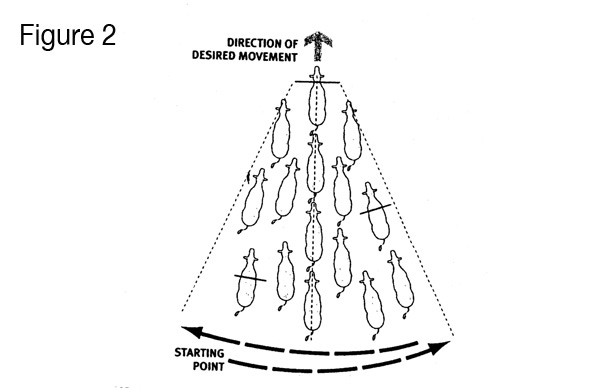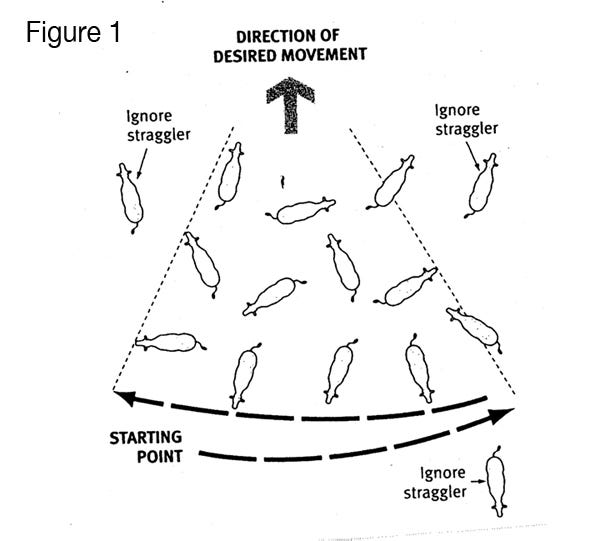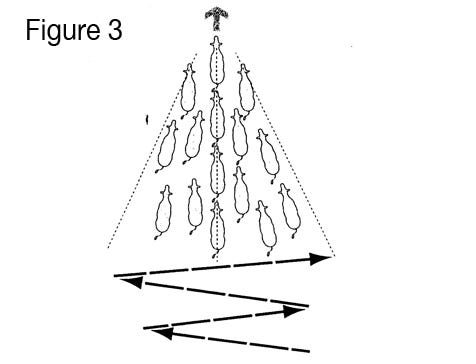People who are just beginning to learn low-stress cattle handling methods on the range need to start on foot and learn how to move with slight body movements.
February 20, 2014

On western ranges under drought conditions, ranchers and range managers are becoming increasingly interested in placing groups of cattle away from riparian areas and inducing them to stay without the use of fences. Bud Williams and other skilled stock people are successful at placing cattle, but it requires a high degree of skill to successfully get cattle to stay where they are placed.
I recently talked to several ranch cowboys who were not able to make the cattle stay where they were placed. Further questioning revealed that they had violated a fundamental basic principle of placing cattle – they admitted to yelling and screaming, which resulted in the mother cows getting separated from their calves. This resulted in the herd returning to their old location.
Tina Williams, the daughter of the late Bud Williams, a cattle handling expert, explained at a recent conference that chasing the cattle to the new location makes the animals feel that the new location is unsafe. Frightened, scared cattle will always return to the original location because they were safe there. It is essential that the cattle move quietly, and cows and calves do not become separated.
If a cow is looking for her calf when she arrives at the new location, it’s likely she will perceive the new location as dangerous. Thus, all movements of stock people, either on foot or on a horse, should be done at a walk. You want cattle moving at a walk. Williams says, “Patience is the key.”
Kent Reeves, another low-stress handling specialist, recommends that people who are just beginning to learn low-stress methods on the range need to start on foot and learn how to move with slight body movements. After they have learned this, they can begin using a horse.
Steps for placing cattle
In her presentation, Tina Williams emphasized the following points. Learning this method will require time and patience.
1. Cattle must be taught to accept pressure from the stock people, BEFORE attempts are made to move and place them. This may take 45-60 minutes.
2. Never chase cattle out of the riparian area. Frightened cattle can’t be successfully placed and they will return to their origin.
3. The zigzag method is done on the edge of flight, and is used to induce the cattle to form a group (Figures 1 and 2). Williams advises, “Let cattle initiate movement.”


In some of my publications, I have stated that cattle should be induced to form a loose bunch BEFORE the zigzag movement is used to enter the flight zone more deeply to start movement (Figure 3). You must practice pressure and release. Continuous pressure will cause cattle to run when they start to move where you want them; back up and reduce pressure. At the end of this article, there is a list of useful publications.

4. Williams says, “Allow the slowest animal to set the speed.” When I talked to one of the cowboys mentioned at the start of this article, he admitted that he was frustrated by the slow cattle. People need to take their time and move at the speed of slowest animal.
5. In previous workshops with Bud Williams, I learned this principle – do not chase a few animals that are stragglers. Leave the cutting horse at home. When low-stress, loose bunching of cattle works, the lone stragglers will come out of the bushes and join the herd. Let the natural motion of the herd attract the stragglers.
6. When you get to the desired location, reduce pressure when you do the zigzag. Make sure the cattle have found the water sources. To begin the process of cattle staying in the desired location, quietly turn the leaders back into the herd.
7. Before the stock people leave the cattle, they must be grazing in random orientations. The stock people MUST NOT leave when the cattle are still lined up. I think a good way to conceptualize this is that the animal’s brain must be in relaxed grazing mode and not in the mode of watching herd mates and moving. Cattle move into random orientation positions when they are relaxed and concentrating on eating.
8. There must be lots of good pasture and feed in the new location. Cattle will not stay in poor pasture, Tina stresses.
Here are some useful publications and websites for more information:
Temple Grandin and Mark Deesing, “Humane Livestock Handling,” Storey Publishing
Temple Grandin is a professor in Colorado State University’s Department of Animal Science.
You might also like:
60+ Photos From 2014 Cattle Industry Convention
CattleFax Outlook: Better Weather & Higher Prices In 2014
Know Which Cows Are Most At Risk To Predators
10 New Farm Trucks To Consider For 2014
You May Also Like



